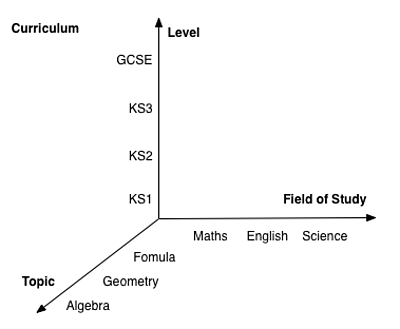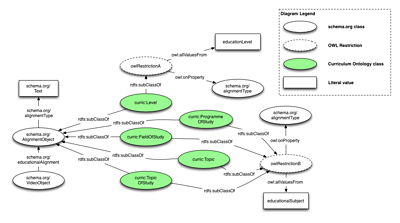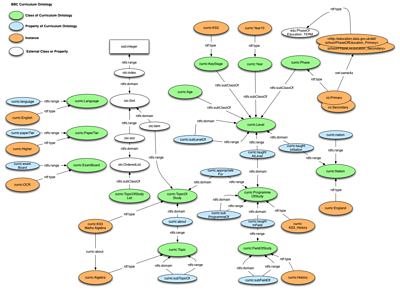Introduction
This ontology provides a data model and vocabularies for describing the National Curricula within the UK. It aims to:
- provide a model of the national curricula across the UK
- organise learning resources, e.g. video clips and revision content
- allow users to discover content via the national curricula
Where possible, the domain model uses curricula terms such as Topic, Field of Study and Programme of Study that are common in the curriculum domain.
The curriculum is modelled as a 3-dimensional space, as shown in the diagram below. Topics of Study, which are the combination of Levels (stages of education), Fields of Study and Topics, are the atomic or elementary units of a curriculum. The generic data model may also be applicable for describing curricula taught in other countries or areas.

Rationale
The Curriculum Ontology has been designed to organise content in a way that allows students and teachers to navigate and discover learning resources via the national curricula. It achieves this by providing broad units of learning (e.g. a Topic) and more granular units of learning (e.g. a Topic of Study). The rationale for these concepts in the domain model are outlined below.
Topic and Topic of Study
A Topic can highlight the content of the learning resources in a more specific way than at just as a Field of Study e.g. Geography. Mapping content to a Topic of Study makes it easy to find specific content whilst mapping to a generic Topic allows users to discover a wider range of content.
A Topic of Study is defined as a Topic in the context of Programme of Study. It addresses the following issues:
- A Topic across Levels. The meaning of a Topic, e.g. Geometry (Shape & Space), can vary for different Levels. Geometry for KS1, ususally called Shape & Space, needs a different description to Geometry in KS3 as KS1 is typically for primary-age students whereas KS3 is for secondary-age students
- A Topic across Fields of Study. For example, "energy resources" is a Topic of Physics and Geography, but the learning content for "physics energy resources" and "geography energy resources" can be different.
- Topic synonyms. The topic of "algebra" is usually described as "relationships" in the Scottish national curricula but is described as "Algebra" in the English curricula.
Topic and Field of Study
A Field of Study could be viewed as just a Topic covering a broader area of learning. The reasons for defining them as two separate concepts are:
- Fields of Study are published by Government bodies. For instance, the Fields of Study taught at primary schools in England are published by the government here. In general the national curricula define the breadth of a field of study but do not provide a prescriptive list of individual topics, although in some levels (e.g. GCSE) exam boards do specify a list of Topics of Study for each Field of Study.
- A Topic across Fields of Study. As mentioned previously, some Topics can be used across Fields of Study.
Ordering of topics of study
The ordering of Topics of Study is a key requirement in the Curriculum Ontology, because some Topics of Study can be pre-requisites of others. For instance, students have to learn the English alphabet before English grammar. The TopicOfStudyList class uses the Ordered List Ontology to curate the sequences of Topics of Study.
Open ends of properties
It worth mentioning that the domains of these four properties: nation, language, examBoard and paperTier, are left open. The purpose is to keep the Curriculum Ontology generic and independent from models of assets and content formats. In other words, these properties can be used to describe arbitrary learning resources
Existing work
During the development of the Curriculum Ontology the following work was reviewed:
The Ordered List Ontology has been adopted to capture the sequential order of Topics of Study. LRMI (Learning Resource Metadata Initiative) was used as a reference. The concept of educational phase was imported from the data schema underlying The 'A Curriculum Ontology' work was a precursor to the development of this ontology.
Mappings to Schema.org
Below we present the mappings between the Curriculum Ontology and the .
The purpose of the mappings is to describe learning resources from an educational perspective using two distinct vocabularies, the Curriculum Ontology and the Schema.org educational vocabulary contributed by . Using these vocabularies to describe learning resources enables easier discovery of content by search engines and other organisations.
The candidate mappings between the Curriculum Ontology and Schema.org are expressed in the figure below.

The diagram demonstrates Curriculum Ontology classes subclassing the Schema.org AlignmentObject. The AlignmentObject describes the alignment between a learning resource and a node in an educational framework. The Curriculum Ontology classes shown in the diagram share the same intent as the Schema.org AlignmentObject, thus the Curriculum Ontology classes sub-class the AlignmentObject class. The AlignmentObject class provides an alignmentType property that describes the type of alignment being specified. In the diagram, there are two types of alignment, 'educationLevel' and 'educationalSubject', these types allow alignment to the respective Curriculum Ontology classes. OWL restrictions are used to enforce that correct alignmentType properties are used.
It is expected that these mappings will evolve with the development of the Schema.org and LRMI vocabularies.

Metadata
| Created | 2013-10-11 |
| Last modified | 2024-05-19 |
| Version | 1.12 |
| Licence | |
| Download | Curriculum ontology (Turtle format) |
Some instance data conforming to the Curriculum Ontology, to which the licence above also applies, can be found .
Classes
Age
| URI | |
| Description | Age or age range is a way to specify the stages of education. |
| Superclasses | , Level, , |
ExamBoard
| URI | |
| Description | Exam board is the organization holds some exams. |
| Superclasses | |
| Range for | examBoard |
ExamSpecification
| URI | |
| Description | An exam specification maintained by an exam board defines the content of an examination.. |
| Superclasses | |
| Domain for | followedAtLevel |
| Range for | examSpecification |
FieldOfStudy
| URI | |
| Description | Fields of study refers to the disciplines of a curriculum, e.g. Science, Maths, Science, etc. |
| Superclasses | |
| Domain for | subFieldOf |
| Range for | subFieldOf, taughtInField |
KeyStage
| URI | |
| Description | Key Stage is a way to specify the stage of the state education system in England, Wales, Northern Ireland. |
| Superclasses | , Level, , |
Language
| URI | |
| Description | Examples of language are English, Welsh, Scottish Gaelic and Irish Gaelic. |
| Domain for | languageCode, usedIn |
| Range for | language |
Level
| URI | |
| Description | Levels refers to the stages of education. Typically, there are four different ways to specify the levels: age range, year, key stage and phase. |
| Superclasses | , , |
| Subclasses | Age, KeyStage, Phase, Year |
| Domain for | lowerAgeBoundary, subLevelOf, taughtInNation, upperAgeBoundary |
| Range for | followedAtLevel, subLevelOf, taughtAtLevel |
Nation
| URI | |
| Description | Nation is the concept to describe the four parts of the UK, i.e. England, Wales, Scotland and Northern Ireland. |
| Range for | nation, taughtInNation, usedIn |
PaperTier
| URI | |
| Description | Paper tier reflects the difficulty of a exam. It can be standard or higher. |
| Range for | paperTier |
Phase
| URI | |
| Description | This concept is borrowed from the controlled terms for describing phase of education, which are published by the data.gov.uk. The phases of education include Primary, Secondary and 16-Plus. |
| Superclasses | , Level, , |
ProgrammeOfStudy
| URI | |
| Description | A programme of study is the combination of a nation, an educational level such as Key Stage 3 and the subject being studied, Science, Maths etc. |
| Superclasses | |
| Domain for | subProgrammeOf, taughtAtLevel, taughtInField |
| Range for | programmeOfStudy, subProgrammeOf |
Topic
| URI | |
| Description | Topic can highlight the content of the learning resources in a way more specific than the Field of Study. For example, energy is a topic of physics. |
| Domain for | subTopicOf |
| Range for | about, subTopicOf |
TopicOfStudy
| URI | |
| Description | Topic of study is topic within the context of a programme of study. It aims to provide a formal learning context to an asset or a collection of assets. |
| Domain for | about, appropriateFor, providesContextTo |
| Range for | includesTopicOfStudy |
TopicOfStudyList
| URI | |
| Description | A ordered list of topics of study |
| Range for | topics |
Year
| URI | |
| Description | Year is a way to specify the stages of education. |
| Superclasses | , Level, , |
Properties
about
| URI | |
| Description | Link topic of study views to topics. |
| Domain | TopicOfStudy |
| Range | Topic |
appropriateFor
| URI | |
| Description | Link topic of study to a programme of study or an Exam Specification. |
| Domain | TopicOfStudy |
curriculumYear
| URI | |
| Description | The year when a curriculum concept is valid. |
| Range |
depictionPID
| URI | |
| Description | The PID of the depiction (image). |
| Range |
examBoard
| URI | |
| Description | Property for associating any concept with an examBoard, e.g. an asset is useful for preparing exams provided by an exam board. |
| Range | ExamBoard |
examSpecification
| URI | |
| Description | Property for associating any concept with an exam specification, e.g. a list of sub-topics is curated for an exam specification. |
| Range | ExamSpecification |
followedAtLevel
| URI | |
| Description | The students at a certain level follow an exam specification. |
| Domain | ExamSpecification |
| Range | Level |
includesTopicOfStudy
| URI | |
| Description | a short cut from a programme of study or a topic of study to the member of its topic of study list |
| Range | TopicOfStudy |
language
| URI | |
| Description | The property of an asset being in a specific language. |
| Range | Language |
languageCode
| URI | |
| Description | The ISO 639 code of the language plus with the ISO 3166 code of the geographic region, for example, en-gb. |
| Domain | Language |
| Range |
lowerAgeBoundary
| URI | |
| Description | The lower bound of the age range of a educational level. |
| Domain | Level |
| Range |
nation
| URI | |
| Description | Specify an asset could be useful for a certain nation |
| Range | Nation |
paperTier
| URI | |
| Description | Specify the difficulty level of an asset |
| Range | PaperTier |
programmeOfStudy
| URI | |
| Description | Specify the programme of study for a concept, e.g. the programme of study that exam specification can assess. |
| Range | ProgrammeOfStudy |
providesContextTo
| URI | |
| Description | Link topics of study to ÃÛÑ¿´«Ã½ assets. |
| Domain | TopicOfStudy |
subFieldOf
| URI | |
| Description | Capture the hierarchy of fields of study. |
| Domain | FieldOfStudy |
| Range | FieldOfStudy |
subLevelOf
| URI | |
| Description | Capture the hierarchy of level. |
| Domain | Level |
| Range | Level |
subProgrammeOf
| URI | |
| Description | Capture the hierarchy of programmes of study. |
| Domain | ProgrammeOfStudy |
| Range | ProgrammeOfStudy |
subTopicOf
| URI | |
| Description | Capture the hierarchy of topics. |
| Domain | Topic |
| Range | Topic |
taughtAtLevel
| URI | |
| Description | Specify the level of a programme of study. |
| Domain | ProgrammeOfStudy |
| Range | Level |
taughtInField
| URI | |
| Description | Specify the field of a programme of study. |
| Domain | ProgrammeOfStudy |
| Range | FieldOfStudy |
taughtInNation
| URI | |
| Description | Specify the nation of a level. |
| Domain | Level |
| Range | Nation |
topics
| URI | |
| Description | Link a topic of study or a programme of study to an ordered list of topics of study. |
| Range | TopicOfStudyList |
upperAgeBoundary
| URI | |
| Description | The upper bound of the age range of a educational level. |
| Domain | Level |
| Range |
usedIn
| URI | |
| Description | The property of a language being used in a nation. |
| Domain | Language |
| Range | Nation |